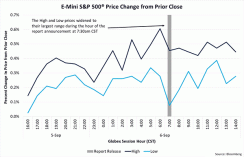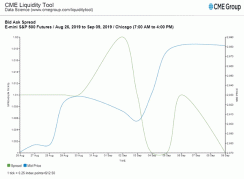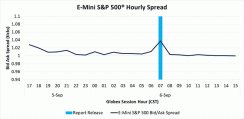By Jesy Beeson, CME Group
At a Glance
- Liquidity in E-Mini S&P 500 futures remained strong despite lower than expected data in the August jobs report.
- Strong liquidity can be crucial to investors, especially when analysts’ expectations miss the mark.
Forecasts vs. Final
Several factors can determine how the market will respond to the report. Often participants react not just to the headline number, but also consider how close the consensus forecast is to the final tally. On September 6, the report showed that the U.S. economy added 130,000 jobs in August, markedly lower than the 160,000 forecast. The tally in the two prior months was also revised down, resulting in 20,000 fewer jobs than had been reported earlier.
Soft jobs numbers can move several markets, but we often see an immediate response in equities. This often results in movement on the E-mini S&P 500 futures contract. After the report was released on September 6, there was a wide price range at the hour of the report’s announcement, but the CME Liquidity Tool shows strong liquidity throughout the event.
Hourly Price Moves
The impact of the jobs report is seen immediately in the hourly high and low prices on the futures contract. The chart below shows the percentage difference between the hourly high and low, and the prior day’s close. There is a clear divergence between 7-8 a.m. CST, right as the report is released. The range between high and low prices extends to nearly 0.4 percent, a high for the day.
Figure 1 – Hourly Price

E-Mini S&P 500 Spreads
As markets absorb economic news, we often see various liquidity metrics react as well. As traders seek to position themselves in the wake of new information, it is critical that markets remain sufficiently liquid. One key metric of this liquidity can be seen in the CME Liquidity Tool, using the Bid/Ask Spread view. This shows the time-weighted average of the spreads throughout the Chicago trading day (7 a.m. – 4 p.m. CST), which will capture all of the market response to the report.
Figure 2 – Bid Ask Spread
At an hourly level, we can see even tighter spreads throughout the day. While the spread clearly responded to the report’s publication at 7:30 a.m. CST, it remained below 1.04. The spread fell below 1.004 in the next hour and remained there for the rest of the Globex session.
Figure 3 – Hourly Bid/Ask Spreads
Maintaining Tight Spreads
Market participants watch several economic indicators to shape their trading strategies. The monthly Employment Situation report can have a significant impact on equities, particularly when the numbers come in lower than forecast, as was the case on September 6 for the August jobs report. Traders often turn to the futures market, and the E-Mini S&P 500 futures contract in particular, to position themselves in the event of a surprise. While such movement can have an impact on liquidity in the contract, we see tight spreads at the day and hour level throughout the trading session.






